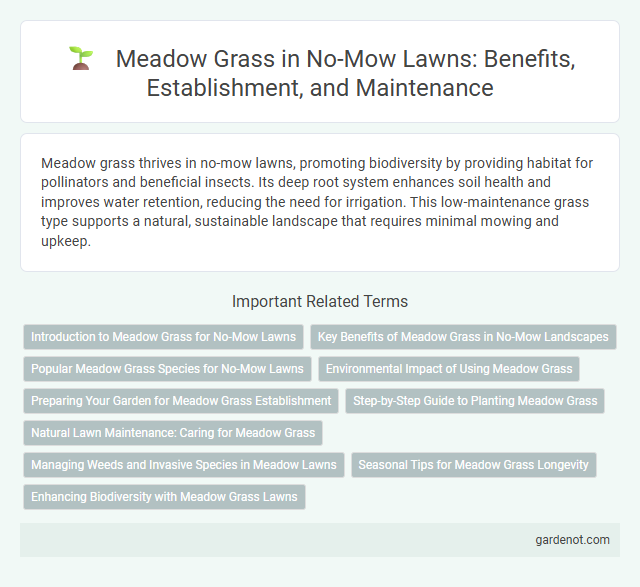Meadow grass thrives in no-mow lawns, promoting biodiversity by providing habitat for pollinators and beneficial insects. Its deep root system enhances soil health and improves water retention, reducing the need for irrigation. This low-maintenance grass type supports a natural, sustainable landscape that requires minimal mowing and upkeep.
Introduction to Meadow Grass for No-Mow Lawns
Meadow grass, a key species for no-mow lawns, thrives in low-maintenance environments and promotes biodiversity by supporting pollinators and native wildlife. Its deep root system enhances soil health, reduces water usage, and prevents erosion, making it an eco-friendly choice for sustainable landscaping. Ideal for homeowners seeking natural aesthetics with minimal upkeep, meadow grass creates vibrant, resilient lawns that require little to no mowing throughout the growing season.
Key Benefits of Meadow Grass in No-Mow Landscapes
Meadow grass in no-mow landscapes promotes biodiversity by providing habitat for pollinators and beneficial insects, enhancing the ecological balance of the area. Its deep root systems improve soil health and water retention, reducing erosion and irrigation needs. Low maintenance requirements and natural resilience make meadow grass an eco-friendly and cost-effective choice for sustainable lawn alternatives.
Popular Meadow Grass Species for No-Mow Lawns
Popular meadow grass species for no-mow lawns include fine fescue, blue grama, and buffalo grass, valued for their low maintenance and drought tolerance. These grasses thrive without frequent mowing, creating naturalistic, eco-friendly landscapes that support biodiversity. Incorporating native meadow grasses enhances soil health and reduces water usage compared to traditional turfgrass.
Environmental Impact of Using Meadow Grass
Meadow grass significantly enhances biodiversity by providing habitat and food sources for pollinators, birds, and beneficial insects, promoting a balanced ecosystem. Its deep root systems improve soil health and water retention, reducing erosion and minimizing the need for irrigation. This sustainable approach to lawn care lowers carbon emissions by eliminating the need for gas-powered mowers and chemical fertilizers.
Preparing Your Garden for Meadow Grass Establishment
Preparing your garden for meadow grass establishment involves selecting well-drained soil with a neutral to slightly acidic pH between 6.0 and 7.0 to support optimal growth. Clear the area of existing vegetation and loosen the soil to a depth of 4-6 inches to enhance seed-to-soil contact and root penetration. Ensure consistent moisture during germination by watering lightly and regularly until the meadow grass seedlings are well established.
Step-by-Step Guide to Planting Meadow Grass
Preparing the soil thoroughly by removing weeds and loosening the top layer is crucial for successful meadow grass planting. Scatter a mixture of native meadow grass seeds evenly across the area, then lightly rake to ensure seeds contact the soil without burying them too deep. Maintain consistent moisture through regular watering until the grass is established, typically within 4 to 6 weeks.
Natural Lawn Maintenance: Caring for Meadow Grass
Meadow grass thrives in natural lawn maintenance by promoting biodiversity and reducing the need for frequent mowing and chemical treatments. Its deep root system enhances soil health and supports pollinators like bees and butterflies. Regularly cutting the grass only once or twice a year encourages wildflowers and maintains a balanced ecosystem within the lawn.
Managing Weeds and Invasive Species in Meadow Lawns
Meadow grass in no-mow lawns thrives with minimal disturbance, requiring strategic management to control weeds and invasive species effectively. Regular monitoring and selective removal of aggressive weeds such as quackgrass and creeping thistle help maintain biodiversity and ecosystem balance. Employing native plant species and promoting healthy soil conditions reduce invasive species' establishment and enhance long-term meadow lawn sustainability.
Seasonal Tips for Meadow Grass Longevity
Meadow grass thrives with seasonal care tailored to its growth cycle, including springtime overseeding to fill bare patches and promote thick turf. In summer, regular but moderate watering helps maintain drought resilience while avoiding overwatering that can lead to fungal issues. Autumn mowing at higher settings encourages root development and prepares the grass for winter dormancy, ensuring long-term vitality without the need for frequent mowing.
Enhancing Biodiversity with Meadow Grass Lawns
Meadow grass lawns support a diverse range of pollinators, birds, and beneficial insects by providing natural habitat and varied flowering plants, significantly enhancing local biodiversity. These low-maintenance lawns reduce the need for chemical fertilizers and pesticides, promoting healthier ecosystems and soil quality. Integrating meadow grass encourages native flora growth, creating sustainable green spaces that contribute to urban wildlife conservation and ecological balance.
Meadow grass Infographic

 gardenot.com
gardenot.com